Apr 20, 2020
The best and worst draft picks in Blue Jays history
Blue Jays front offices have a history of swinging and missing in the first round, but they did nail a certain 17th overall selection and have unearthed some gems in the later rounds over the years, Scott Mitchell writes in the sixth of his nine-part series that looks at the best and worst in the franchise’s history.
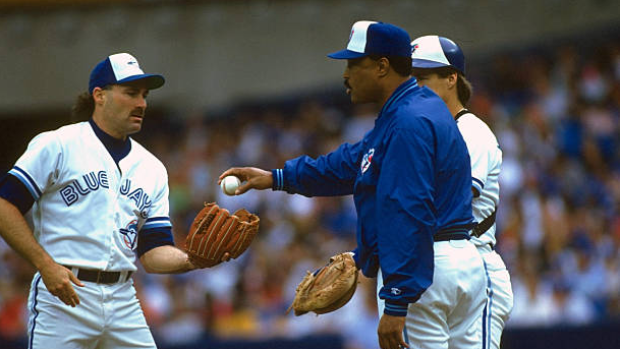
TORONTO — As a franchise, the Toronto Blue Jays have an up-and-down history at the draft table.
The problem, however, is that very few of the best picks made by Jays front offices have come in the past 20 years.
On the bright side, the current regime’s drafting acumen has turned things around in a big way, with the likes of Bo Bichette, Cavan Biggio and Nate Pearson ready to start paying dividends.
But prior to that it was ugly.
In franchise history, the Jays have selected eight players in the first round that have gone on to accumulate 20-plus bWAR.
Only one of them — infielder Aaron Hill with 24.4 bWAR from the 2003 draft — was picked in the 21st century.
Roy Halladay (64.2 bWAR), Shawn Green (34.7), Chris Carpenter (34.2), Vernon Wells (28.6), Lloyd Moseby (27.5), Alex Rios (27.3) and Shannon Stewart (24.9) were all drafted prior to 2000.
Meanwhile, the next six names on that productivity lists are all pitchers, and most were drafted more recently, but the problem is many were either used as trade chips or simply didn’t last.
That list is made up of Noah Syndergaard (15.7 bWAR), Marcus Stroman (14.7), James Paxton (13.3), Steve Karsay (11.2), Ricky Romero (9.9) and Aaron Sanchez (8.9).
While there are usually 39 other rounds to make up for it, blowing or trading away early picks isn’t something contenders make a habit out of.
Even though Blue Jays front offices have a history of swinging and missing in the first round, as evidenced by the list of worst draft picks you’re about to read, they did nail a certain 17th overall selection, in addition to unearthing some gems in the later rounds over the years.
The Best and Worst of the Blue Jays on TSN.ca:
Mon, April 6 – The five best and worst signings
Wed, April 8 – The five best and worst outfielders
Fri, April 10 – The five best and worst games
Mon, April 13 – The five best and worst trades
Wed, April 15 – The five best and worst infielders
Fri, April 17 – The five best and worst seasons
Mon, April 20 – The five best and worst draft picks
Wed, April 22 – The five best and worst pitchers
Fri, April 24 – The five best and worst moments
Best Draft Picks
BONUS—Orlando Hudson, 1,280th overall (43rd round) in 1997; Kevin Pillar, 979th overall (32nd round) in 2011
They weren’t stars, and they’re far from the only examples of late draft picks working out, but uncovering a diamond in the rough past the 30th round is not common.
The Jays found a pair of them almost 15 years apart.
Hudson took five years to reach the majors, but once he did the scrappy second baseman was a fan favourite in Toronto before J.P. Ricciardi dealt the O-Dog to the Arizona Diamondbacks in the deal for third baseman Troy Glaus.
Over 11 seasons, Hudson ended up winning four Gold Gloves, making two all-star games, and finishing with 21.1 fWAR.
Fourteen years later they found another late gem who earned a nickname and became a fan favourite, selecting Pillar in the 32nd round.
Thanks to a no-holds-barred approach to defence, Superman showed up almost nightly on the highlight reels during the 2015 and ’16 seasons and has been worth 11.8 fWAR through his first seven big-league seasons.
5. Pat Hentgen, 133rd overall (Fifth Round) in 1986
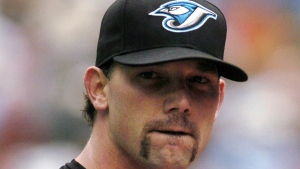 The Jays dipped into the Michigan high school ranks in ’86 to select Pat Hentgen, who would eventually arrive as a rotation stalwart in 1993 with 19 wins and a 3.87 ERA.
The Jays dipped into the Michigan high school ranks in ’86 to select Pat Hentgen, who would eventually arrive as a rotation stalwart in 1993 with 19 wins and a 3.87 ERA.
A three-time all-star, Hentgen claimed the 1996 American League Cy Young Award, throwing 10 complete games and 265.2 innings on his way to a 20-10 record and a 3.22 ERA.
Hentgen led all of baseball in complete games over the ’96 and ’97 seasons, finishing what he started a whopping 19 times in 70 starts.
He accumulated 23.7 fWAR over the course of his career, sixth most in franchise history amongst pitchers.
One of them is Jimmy Key (28.1 fWAR, third in franchise history), who didn’t quite make this list but deserves a hat tip as a third-round pick from the 1982 draft.
4. John Olerud, 79th overall (Third Round) in 1989
Health concerns and bonus demands helped drop Olerud all the way to the third round in a 1989 draft that featured right-handed pitcher Ben McDonald going first overall to the Baltimore Orioles and Hall of Famers Frank Thomas, Jeff Bagwell, Trevor Hoffman and Jim Thome picked.
Amazingly, Olerud was pushed right to the major leagues that summer without ever having played a game in the minors, and did not look out of place with three singles in eight at-bats.
Three seasons of solid production to begin his career gave way to a 1993 season for the ages that saw Olerud produce a career best 8.1 fWAR and threaten the .400 mark for much of the summer.
Olerud’s .293 career average places him sixth in franchise history, behind Paul Molitor (.315), Roberto Alomar (.307), Frank Catalanotto (.299), Shannon Stewart (.298) and Tony Fernandez (.297).
3. Jesse Barfield, 233rd overall (Ninth Round) in 1977
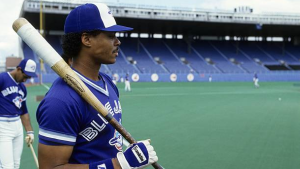 With the Jays and GM Peter Bavasi at the draft table for the first time ever, future Hall of Famer Harold Baines was selected first overall by the Chicago White Sox, while Paul Molitor went third.
With the Jays and GM Peter Bavasi at the draft table for the first time ever, future Hall of Famer Harold Baines was selected first overall by the Chicago White Sox, while Paul Molitor went third.
Eight rounds and 232 picks after Baines was selected, the Jays plucked Barfield, a strong-armed outfielder from the Illinois high school ranks.
Debuting four years later at the age of 21, Barfield’s power and weapon for an arm in right field led to 29.6 fWAR during his Blue Jays career, fourth among all position players in franchise history.
Barfield’s career year came in 1986 when he slugged 40 homers.
2. Dave Stieb, 105th overall (Fifth Round) in 1978
The 1978 draft was kind to the Blue Jays as they grabbed Lloyd Moseby second overall and then followed that up in the fifth round with one of the best picks in franchise history, getting Stieb 103 picks after their future centre fielder.
A borderline Hall of Famer who may still have his case reviewed one day, Stieb was worth 43.6 fWAR during his career in Toronto and was considered one of the best pitchers in baseball for an entire decade after his debut in 1979.
A college outfielder and late bloomer on the mound, only Jack Morris won more games in the 1980s and Stieb’s 175 wins, 1,658 strikeouts, 103 complete games, 30 shutouts, and 2,873 innings still top the Jays’ franchise leaderboard by a country mile.
Stieb, known for his fiery demeanour, also hit a franchise record 129 batters.
1. Roy Halladay, 17th overall (First Round) in 1995
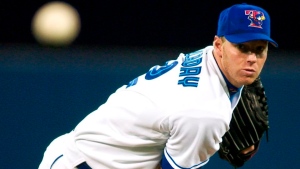 Based on the value of where Stieb was picked and the fact Roy Halladay was a first-rounder, many will argue this order should be revered.
Based on the value of where Stieb was picked and the fact Roy Halladay was a first-rounder, many will argue this order should be revered.
It came down to one thing: Halladay is in Cooperstown.
It doesn’t get any better than drafting a Hall of Famer. They’re in a class all by themselves for a reason.
The Jays were able to nab Halladay just past the midway point of the first round thanks to a disappointing 55-60 record in the strike shortened 1994 campaign, and it took the Denver native a little more than three years to reach the big leagues.
Of course, everyone remembers Halladay flirting with a no-no in his second big-league start. We also remember how everything fell apart in 2000 and 2001, forcing Halladay and the Jays back to the drawing board.
The rest is history, as Halladay was one of the most dominant starters in baseball from 2002 through 2011, racking up eight all-star appearances and a Cy Young Award in each league.
Halladay’s .661 winning percentage as a starter is second in franchise history to Roger Clemens’ .759 mark, while his 48.6 fWAR in a Jays uniform is the best ever.
The Worst Picks
5. Max Pentecost, 11th overall (First Round) 2014
We’ll start with a fairly recent example of swinging and missing with a first-round pick.
Seen as an advanced hitter as a catcher coming out of Kennesaw State University in Georgia, Pentecost spent four seasons in the minors and generally looked the part, batting .280 across 260 games and reaching Double-A in 2018.
The issue, however, was that after GM Alex Anthopoulos signed him for $2.9 million, Pentecost’s body began to fail him, and he missed the entire 2015 season due to shoulder surgery.
Injury issues, including more shoulder problems, continued to dog him and Pentecost retired last year having never made it past Double-A.
Players drafted after Pentecost include shortstop Trea Turner (13th), third baseman Matt Chapman (25th), and right-hander Jack Flaherty (34th).
4. Deck McGuire, 11th overall (First Round) in 2010
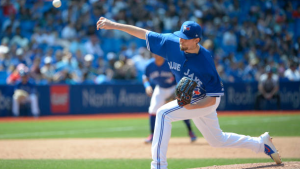 The selection of McGuire in 2010 stings for a couple of reasons.
The selection of McGuire in 2010 stings for a couple of reasons.
The first is obvious.
The 6-foot-6 right-hander is now approaching his 31st birthday and he’s only made 27 appearances in the majors, debuting in 2017 after he was long gone from the Jays organization.
The second is what makes this pick a tough one to swallow, as McGuire, who pitched at Georgia Tech, was selected one pick before Yasmani Grandal, now one of the best catchers in baseball, and two before Chris Sale, who had a run of seven straight top six Cy Young finishes snapped last season.
Considering Grandal was at the University of Miami and Sale was pitching at Florida Gulf Coast, it’s not like they were secrets to the Jays and then amateur scouting director Andrew Tinnish – they simply selected the wrong guy.
They did make up for it a little later on, picking Aaron Sanchez 34th and Noah Syndergaard 38th.
3. Jay Schroeder, third overall (First Round) in 1979
You know when your resume says Super Bowl champion and 1986 Pro Bowler that your baseball career probably didn’t go as planned.
The Jays obviously didn’t have that kind of foresight when they selected Schroeder third overall in 1979 out of the California prep ranks as a catcher.
Sent to Medicine Hat in the Pioneer League in 1980, the soon-to-be quarterback batted just .234 as a 19-year-old, far from the worst possible outcome at the time.
But things fell apart as the competition got better and Schroeder gave up baseball with a career .213 average after the 1983 season.
A year later, the Washington Redskins chose the UCLA quarterback in the third round of the 1984 NFL Draft.
The best players picked behind Schroeder in 1979 were Andy Van Slyke, sixth overall to the St. Louis Cardinals, and Tim Wallach, 10th overall to the Montreal Expos.
2. Garry Harris, second overall (First Round) in 1980
One pick after the New York Mets nabbed Darryl Strawberry with the first-overall pick, the Jays decided to go with a shortstop out of Herbert Hoover High School in San Diego named Garry Harris.
Sent to their Alberta affiliate in Medicine Hat, Harris was fine at the plate, batting .272 as a rookie, but the glove was a different story as he committed a comical 54 errors. It only led the league by 27(!).
Harris holds the distinction of being one of four second-overall picks in the 20th century to never make the majors, joined by Mark Merchant (1987), Mike Lentz (1975) and …
1. Augie Schmidt, second overall (First Round) in 1982
Just imagine holding the second pick in two of three drafts to start the decade and neither making the major leagues.
Not even a cup of coffee.
That’s exactly what GM Pat Gillick faced early in his tenure, and even though the draft process was even more of a shot-in-the-dark crapshoot back then than it is today, it still wasn’t pretty.
As the Golden Spikes Award winner as the nation’s top amateur player, Schmidt was supposed to be good.
So good, in fact, that he went three picks ahead of some guy named Dwight Gooden.
Not so much.
Schmidt toiled in minor-league obscurity for three seasons, before being traded to the San Francisco Giants and retiring in 1986.


